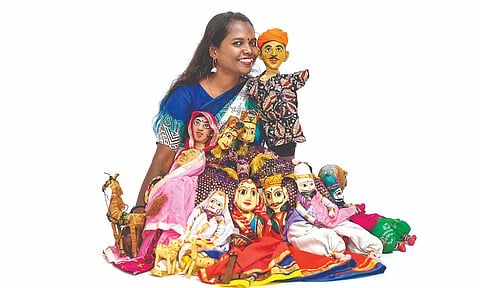

CHENNAI: Post pandemic, oodles have changed in the way we bide in Chennai. For Rathy, a puppeteer, it has been staging her act before desolate seats. “Puppetry is an art form passed from generations among families as a family tradition. But now, there aren’t many takers who continue or support the art. Performing inside an empty theatre is prosaic,” Rathy states.
Originally from Thenkalam village in the Tirunelveli district, the 38-year-old is also a reading consultant and a storyteller. “I design reading programs for schools where I kinder the joy of reading storybooks through elements of storytelling, puppetry and theater,” she explains.
An ancient form of theatre, puppetry dates back to the 5th century BC in Ancient Greece. Although, every country has an origin story of the puppetry they perform. “In India, Tamil Nadu is believed to be the place where we have recorded evidence of puppetry, Tholpavakoothu performed as early as the 18th century. We used the puppets largely to tell stories of Ramayana and Mahabharatha,” Rathy highlights.
She began her journey as a puppeteer in 2014, where the puppeteer was supposed to attend a workshop by a traditional artiste, but got canceled as very few people enrolled. Her interest piqued and she sought out artistes who performed puppetry, wherein she would attend their shows and request them to teach her.
“I would work with them to make and manipulate the puppets. I lived away from my family for a considerable time. They didn’t know I was doing puppetry. They are now supportive after they came to know of my skills. My mother and sister would help me build the set up and create costumes of my puppets,” she says.
Rathy started off as a performance storyteller who used voice and body language, until she started learning mask storytelling and puppetry, which she got hooked onto. Now her performances are 10% using balinese masks, 70% using her puppets, with a side of performance storytelling of about 20%.
“While there are several contemporarily built puppets out there, I prefer performing with traditional puppets that are made by artisans for over a 1,000 years. When I had just started learning puppetry, I saw this beautiful set of puppets sold for Rs 100 in Kerala. I was a little miffed that these indigenous art forms were sold as wall decoration,” she narrates.
“I started seeking out artistes whose families have been making puppets for years. I have been collaborating with them. My Kathputli are from Jaipur, hand puppets from Tilonia, and shadow puppets from Hospet and Nimmalakunta. I also have transformed some coir craft from Odisha into puppets,” Rathy elucidates.
The puppeteer prefers telling fun stories where there are elements of song and dance. Her stories are interactive, where the audience solve mysteries along with the puppets.
“I am very particular about my stories not having a moral value. I have done theme based sessions for autism awareness, Situation Awareness (SA), wetland conservation and mental health. But stories have multiple aspects to them. To reduce it to a simple one-line moral doesn’t do any justice to it,” the artiste states.
Talking about the dying art form of puppetry, Rathy expounds, “Across Jaipur, the artistes wait for someone to pay them Rs 50 so that they can show their puppets to the tourists. Sometimes they go unnoticed for an entire day, as they are usually allotted a corner away from the main crowd,” she states.
“I am constantly looking for work. The puppets are expensive, each one being Rs 1500 and more. But I have been working with performance art in various capacities since 2009, ever since abandoning the ideal career path. And that is not going to change anytime soon,” Rathy adds.